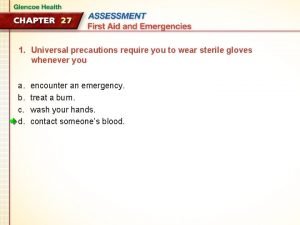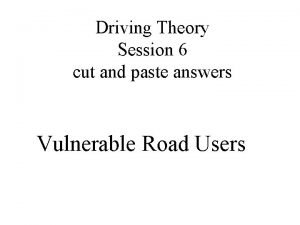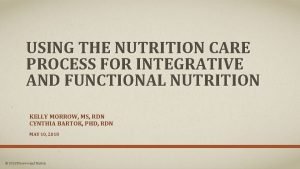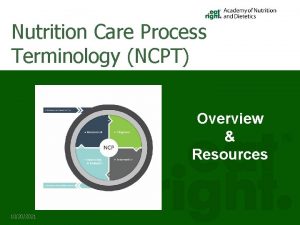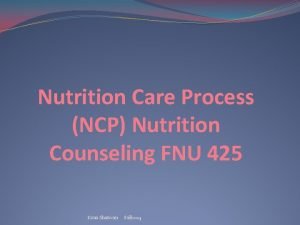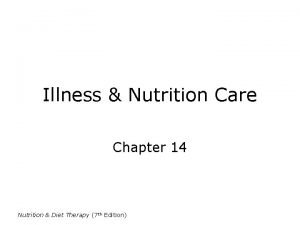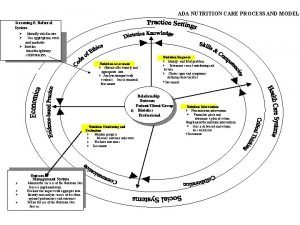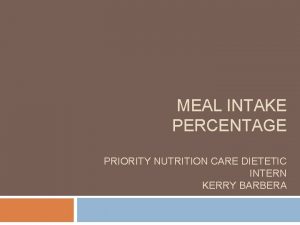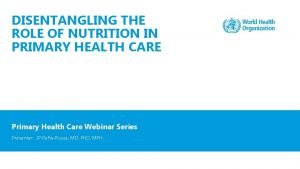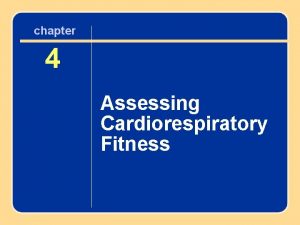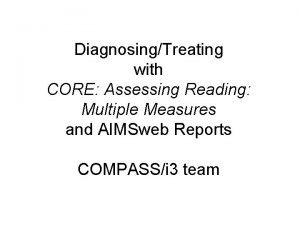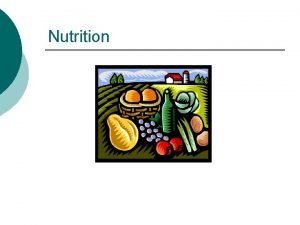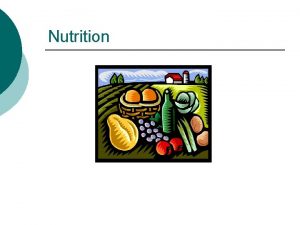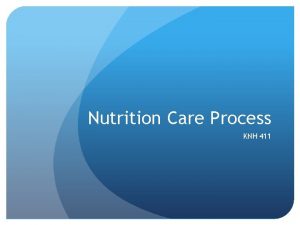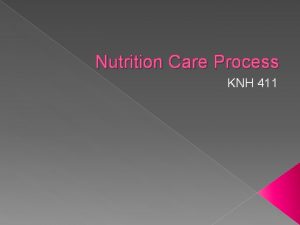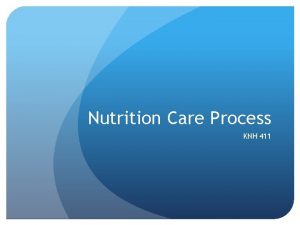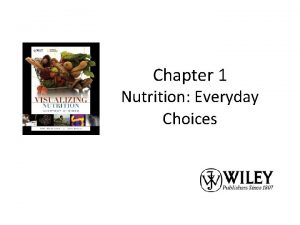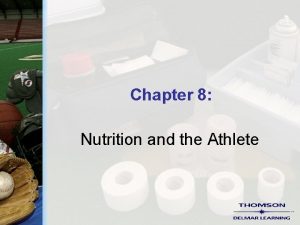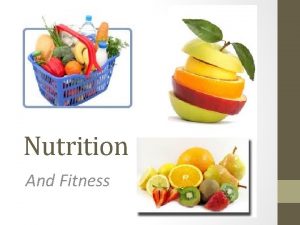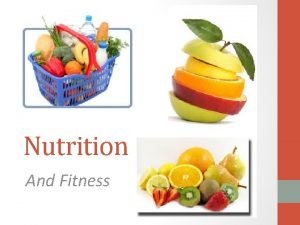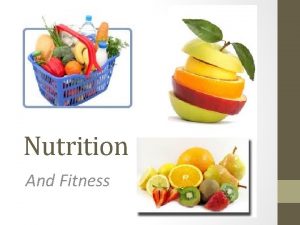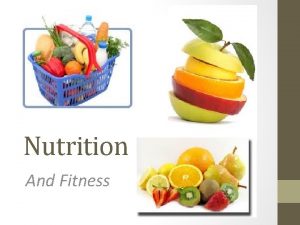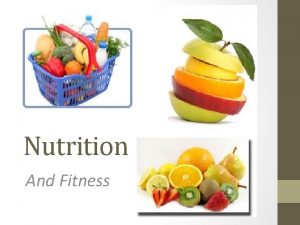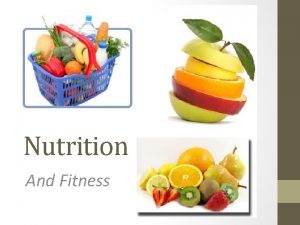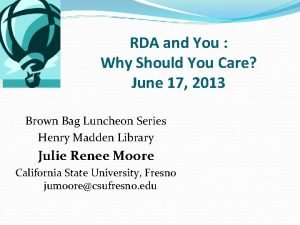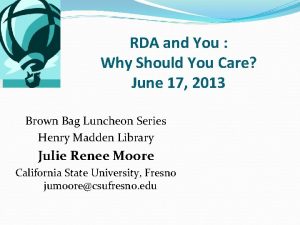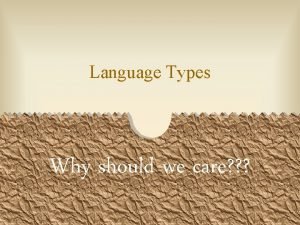Chapter 5 Nutrition Why Should You Care Assessing


















































- Slides: 50

Chapter 5: Nutrition

Why Should You Care?

Assessing Eating Behaviors Hunger: physiological impulse to seek food prompted by the lack/shortage of basic foods needed to provide the energy and nutrients that support health Nutrients: Components of food that sustain humans physiologically Water, Proteins, Carbohydrates, Fats, Vitamins, Minerals Most of us because of appetite, not hunger Psychological, not physiological - What influences this?

Assessing Eating Behaviors (cont. ) Nutrition - science that investigates the relationship between physiological function & the essential elements of the foods eaten. Understanding nutrition allows us to make informed choices about what we eat Fact: poor diet is a major risk factor for 3 of the top 5 causes of death Heart Disease, Cancer, Stroke

Essential Nutrients • Nutrients the body can’t synthesize – must be obtained from food. • Water, proteins, carbohydrates, fats – Macronutrients • Vitamins, Minerals - Micronutrients • Which of the essential nutrients do you think we need in larger quantities?

Calories • A kilocalorie is a unit of measure to quantify the energy in food that the body can use. • Most nutrition labels use the word calorie to refer to kilocalories. • Energy is defined as the capacity to do work. • Energy-containing nutrients are proteins, carbohydrates, and fat Chicken, Beef, Fruits, Veggies, Dairy, Oils, Meat, Legumes, Grains Starches (cereal, bread, pasta) Diary, Fish

The Digestive Process © 2018 Pearson Education, Inc.

Water: A Crucial Nutrient • Humans can survive longer without food than without water. • Essential for chemical reactions, regulates body temp. , component of blood (carries oxygen, nutrients, hormones), removes waste • Dehydration cause serious problems within hours. • Abnormal depletion of body fluids • Too much water can also pose a serious risk. • The body is made up of 50 to 70 percent water by weight.

© 2018 Pearson Education, Inc.

Proteins • Next to water, the most abundant substances in the body. • Proteins are: major components of nearly every cell, called “body builders” bone, muscle, skin, and red blood cells. • Also the key elements of antibodies.

Proteins (cont. ) • When you consume proteins, your body breaks them down into smaller molecules known as amino acids, the building blocks of protein. • Nine of the 20 different amino acids are termed essential amino acids, meaning that the body must obtain them from the diet; • The other 11 can be produced by the body. • Dietary protein that supplies all the essential amino acids is called complete (high-quality) protein. • Proteins from plant sources are often incomplete • May lack one or two of the essential amino acids. • Those who do not eat meat to combine plant foods effectively and eat complementary sources of plant protein

Complete vs. Incomplete Proteins

Complementary Proteins

Build a Pizza HTTP: //MEDIA. PEARSONCMG. COM/BC/BC_0 MEDIA_HK/NUTRITOOLS/HTML 5/B UILDAPIZZA/INDEX. HTML

Build a Salad

Carbohydrates • Carbohydrates supply us with the energy needed to sustain normal daily activity. • Converted to glucose – assists in functioning of internal organs, nervous system, muscles • The body metabolizes carbohydrates more quickly and efficiently than it does proteins. • The two major types are simple carbohydrates and complex carbohydrates.

Simple Carbohydrates • Americans consume large amounts of simple carbohydrates in their diets. • Simple carbohydrates provide short-term energy; they are also known as simple sugars. • Examples of simple sugars: • Sucrose – table sugar • Fruits, berries – fructose (fruit sugar) • Lactose – Milk, dairy (milk sugar) • Maltose – Obtained in the process of allowing grain to soften in water and germinate (Malt sugar)

Simple Carbohydrates (cont. ) • Body converts all simple sugars to glucose provides energy to cells • Americans consume too many refined carbohydrates • contain only sugars and starch • Sugar is found in foods such as ketchup, barbeque sauce, and flavored coffee creamers. • Read the labels!!!!

See It! Video: Ditching Sugar http: //abcnews. go. com/Health/video/new-year-new-you-15299203 Discussion Questions 1. What can you do to avoid overconsumption of sugar? 2. Why is added sugar unhealthy? What diseases can occur due to consuming high amounts of added sugar? 3. What are some of the replacement (counterconditioning) tactics that can help cut back on our “want” of added sugar?

Complex Carbohydrates • Complex carbohydrates provide sustained energy. • Found in grains, cereals, legumes, veggies • Must be broken down into simple sugars before the body can use them. • Starches, glycogen, and fiber are main types of complex carbohydrates. • come from many sources such as flour, pasta, rice, corn, and potatoes. **Can also be stored in the body’s muscles and the liver as glycogen. • When the body needs energy, it breaks glycogen down into glucose.

Build a Sandwich © 2018 Pearson Education, Inc.


Chia Recipes

Fiber • Indigestible portion of plant foods that helps move foods through the digestive system • Found in fruits, vegetables, nuts, and grains. • Delays absorption of cholesterol and other nutrients • Softens stools by absorbing water

Fiber Classification of fiber types is either soluble or insoluble. Soluble fibers can dissolve in water, form gel-like substances, and can be easily digested by bacteria in the colon. Food sources: Citrus Fruits, Berries, Oat bran, dried beans Insoluble fibers typically do not dissolve in water and cannot be fermented by bacteria in the colon. Food Sources: Most fruits, Vegetables, Whole Grains (brown rice, wheat, bran)



See It! Video: Grain Labels Do Not Reflect “Whole” Truth Discussion Questions 1. How can we raise consumer awareness that there is a discrepancy between the marketing of grain products and the actua contents of grain products for consumption? 2. How can companies be held to a better standard to be more honest regarding the contents of products? 3. Provide an argument for the need for the FDA to define whole grains.

Fats • The most energy-dense source of calories in the diet. • Benefits: help maintain healthy skin and hair, insulate body organs, maintain body temperature, and promote healthy cell function. • Make foods taste better and carry fat-soluble vitamins A, D, E, and K to the cells. • Provide a concentrated form of energy in the absence of sufficient amounts of carbohydrates • make you feel full after eating.

Fats (cont. ) • Triglycerides are the most common form of fat circulating in the blood (95 percent of total body fat). • Cholesterol constitutes some of the remaining 5 percent of body fat, and it can accumulate as plaque on the inner walls of arteries, making it a major cause of atherosclerosis. • High-density lipoproteins (HDLs) • Low-density lipoproteins (LDLs)

Types of Dietary Fats • Saturated fats • Derived mostly from animal sources and are solid at room temperature • Unsaturated fats • Derived mostly from plants and are liquid at room temperature • Monounsaturated fatty acids • Polyunsaturated fatty acids • Linoleic acid is an omega-6 fatty acid. • Alpha-linolenic acid is an omega-3 fatty acid.

Avoiding Trans Fatty Acids • Trans fats (trans fatty acids) are fatty acids that are produced when polyunsaturated oils are hydrogenated to make them more solid. • Trans fats increase LDL cholesterol levels while decreasing HDL cholesterol levels.

New Fat Advice: Is More Fat Even Better? • Moderation is the key. • Less than 10 percent of your total calories should come from saturated fat, and no more than 35 percent should come from all forms of fat. • Switching to beneficial fats without increasing total fat intake is ideal.

Build a Meal

Vitamins • Essential organic compounds • Promote growth and reproduction, maintain health. • Vitamins can be either fat-soluble (vitamins A, D, E, and K) or water-soluble (B-complex vitamins and vitamin C). • Maintain nerves and skin, produce blood cells, build bones and teeth, heal wounds • Convert food energy to body energy.

Antioxidants • Beneficial foods are termed functional foods. • Some of the most popular functional foods today are items containing antioxidants or other phytochemicals. • Antioxidants are believed to protect against oxidative stress and tissue damage at the cellular level. • Carotenoids are fat-soluble plant pigments with antioxidant properties

Minerals • Minerals are inorganic, indestructible elements that aid physiological processes. • Macrominerals - body needs in fairly large amounts. • Sodium, Calcium, Potassium • Trace minerals - body needs in very small amounts. • Iron, Zinc, Flouride, Iodine

Sodium

Calcium and Iron Calcium • Plays a vital role in building strong bones and teeth • Aids muscle contraction, blood clotting, regulation of the heartbeat • Maintains the fluid balance within cells. Iron • Necessary for the production of hemoglobin. • Deficiency leads to anemia

How Can I Eat More Healthfully? • A healthful diet provides the combination of energy and nutrients needed to sustain proper functioning. • A healthful diet should be: • Adequate • Moderate • Balanced • Varied • Nutrient dense

Trends in Per Capita Nutrient Consumption

My. Plate Plan

Use the My. Plate Food Guidance System • My. Plate’s key messages include: • Focus on nutrient density from each food group • Eat seafood, high in omega 3 fatty acids, twice a week • Foods to limit or avoid • Foods that represent empty calories (those from sugar and saturated fats) • Examples include sausage, cheese, refined grains, most desserts, sugary drinks and alcoholic beverages • Engage in physical activity

See It! Video: Menu Calorie Counts https: //mediaplayer. pearsoncmg. com/assets/secs-hk-abc-menu-calorie-counts Discussion Questions 1. Is the new federal law, which requires posting calorie counts for foods, beneficial or detrimental for restaurant goers? 2. In what ways is the calorie count advertised misleading for customers? 3. Caloric needs are based on several factors. Does the average person have the knowledge to accurately assess caloric intake needs? What more can be done to educate the public regarding caloric needs? 4. What practical methods can the consumer employ to decrease calorie intake at restaurants?

Supplements: Research on the Daily Dose • Dietary supplements are products—usually vitamins and minerals— taken by mouth and intended to supplement existing diets. • It is important to note that dietary supplements are not regulated by the FDA, like other food and drug products.

Eating Well in College • If you must eat fast food, try to follow these tips to get more nutritional bang for your buck: • • Request nutritional information Order salads, but be careful about what you add to them. Try baked fries. Avoid giant sizes and refrain from ordering “extra. ” • Beware of high sodium, sugar, and fat content in some ethnic foods • Limit beverages and foods that are high in added sugars. • At least once per week, order a vegetable-based product instead of meat when you’re eating fast food

Eating Well in College (cont. ) • In the dining hall, try these ideas: • Choose lean meats, grilled chicken, or vegetable dishes. • Avoid fried foods. • Select leafy greens and healthy fats at the salad bar. • Get creative with your meals: have a baked potato with salsa instead of sour cream. • Avoid large portions and going back for seconds. • Look for protein options including lentils, black beans, brown rice and tofu • Choose fruit or low-fat yogurt to satisfy your sweet tooth.

Choosing Organic or Locally Grown Foods • Organic foods and beverages are developed, grown, or raised without the use of synthetic pesticides, chemicals, or hormones. • It is almost impossible to assess the health impact of organic versus nonorganic foods. • A locavore is someone who eats only food grown close to home.

See It! Video: Organic Produce Discussion Questions 1. What is the justification for the higher cost of organic foods? Describe reasons you think organic food is or is not worth the higher price tag. 2. Describe the benefits to eating organic foods.

Genetically Modified Food Crops • Additives are substances added to food to reduce the risk of foodborne illness, prevent spoilage, and enhance the way foods look and taste. • Genetically modified foods are foods derived from organisms whose DNA has been altered by using genetic-engineering techniques.
 Pictures
Pictures Wh tongue twisters
Wh tongue twisters Primary secondary tertiary health care
Primary secondary tertiary health care Cultural dynamics in assessing global markets
Cultural dynamics in assessing global markets Assessing health status chapter 22
Assessing health status chapter 22 You should always seek professional medical care for
You should always seek professional medical care for How will a school crossing patrol signal you to stop?
How will a school crossing patrol signal you to stop? Foods used in nutrition activities should be nutrient-dense
Foods used in nutrition activities should be nutrient-dense Dont ask
Dont ask Nutrition care process
Nutrition care process Nutrition care process terminology
Nutrition care process terminology Pes statement examples
Pes statement examples Ada 411
Ada 411 Chapter 14 nutrition and fluid balance
Chapter 14 nutrition and fluid balance Nutrition care process
Nutrition care process Abbott percentage of intake chart
Abbott percentage of intake chart Nutrition in primary health care
Nutrition in primary health care What are the three stages of passing
What are the three stages of passing 1. the space between traffic clusters is called a(n)
1. the space between traffic clusters is called a(n) List eight types of facial cosmetics and how they are used
List eight types of facial cosmetics and how they are used Assessing risk in sport regulatory bodies
Assessing risk in sport regulatory bodies Unit 18 assessing children's development support needs p1
Unit 18 assessing children's development support needs p1 Teaching and assessing grammar in the writing classroom
Teaching and assessing grammar in the writing classroom Domain 4 curriculum and planning
Domain 4 curriculum and planning Assessing need for hrd
Assessing need for hrd Informal assessment examples
Informal assessment examples Manual for assessing safety hardware
Manual for assessing safety hardware Assessing a new venture's financial strength and viability
Assessing a new venture's financial strength and viability Assessing cardiorespiratory fitness
Assessing cardiorespiratory fitness Assessing leadership and measuring its effects
Assessing leadership and measuring its effects Module 4 topic 1 assessing and managing risk
Module 4 topic 1 assessing and managing risk Module 4 topic 1 assessing and managing risk
Module 4 topic 1 assessing and managing risk A nine box matrix requires assessing employees on ________.
A nine box matrix requires assessing employees on ________. Oecd maps
Oecd maps Core assessing reading multiple measures
Core assessing reading multiple measures Ar = ir x cr x dr
Ar = ir x cr x dr Amc math assessment
Amc math assessment Assessing motivation to change
Assessing motivation to change Assessing opportunity cost involves
Assessing opportunity cost involves Assessing the situation
Assessing the situation Cultural dynamics in assessing global markets
Cultural dynamics in assessing global markets Assessing value for money
Assessing value for money Parental capacity example
Parental capacity example Factual topics for group discussion
Factual topics for group discussion Dominant work values in today's workforce
Dominant work values in today's workforce Cultural dynamics in assessing global markets
Cultural dynamics in assessing global markets Assessing the internal environment of the firm
Assessing the internal environment of the firm Assessing hrd needs
Assessing hrd needs Chapter 1 should you become an entrepreneur
Chapter 1 should you become an entrepreneur Chapter 1 should you become an entrepreneur
Chapter 1 should you become an entrepreneur Chapter 1 should you become an entrepreneur
Chapter 1 should you become an entrepreneur





